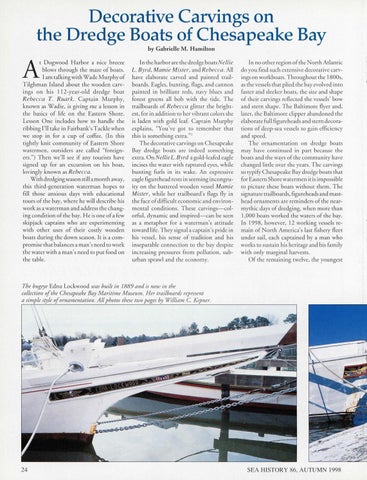Decorative Carvings on the Dredge Boats of Chesapeake Bay by Gabrielle M. Hamilton
A
t Dogwood Harbor a nice breeze blows through the maze of boats. I am talking with Wade Murphy of Tilghman Island about the wooden carvings on his 112-year-old dredge boat Rebecca T. Ruark. Captain Murphy, known as Wadie, is giving me a lesson in the basics of life on the Eastern Shore. Lesson One includes how to handle the ribbing I'll take in Fairbank's Tackle when we stop in for a cup of coffee. (In this tightly knit community of Eastern Shore watermen, outsiders are called "foreigners.") Then we'll see if any tourists have signed up for an excursion on his boat, lovingly known as Rebecca. With dredging season still a month away, this third-generation waterman hopes to fill those anxio us days with educational tours of the bay, where he will describe his work as a waterman and address the changing condition of the bay. H e is one of a few skipjack captains who are experimenting with other uses of their costly wooden boats during the down season. It is a compromise that balances a man's need to work the water with a man 's need to put food on the table.
In the harbor are the dredge boats Nellie L. Byrd, Mamie Mister, and Rebecca. All have elaborate carved and painted trailboards. Eagles, bunting, flags, and cannon painted in brilliant reds, navy blues and forest greens all bob with the tide. The trailboards of Rebecca glitter the brightest, for in addition to her vibrant colors she is laden with gold leaf. Captain Murphy explains, "You've got to remember that this is something extra." 1 The decorative carvings on Chesapeake Bay dredge boats are indeed something extra. On Nellie L. Byrd a gold-leafed eagle incises the water with raptured eyes, whil e bunting furls in its wake. An expressive eagle figurehead rests in seeming incongruity on the battered wooden vessel Mamie Mister, while her trailboard's flags fly in the face of difficult economic and environmental conditions. These carvings-colorful, dynamic and inspired-can be seen as a metaphor for a waterman's attitude toward life. They signal a captain's pride in his vessel, his sense of tradition and his inseparable connection to the bay despite increasing pressures from pollution, suburban sprawl and the economy.
In no other region of the North Atlantic do you find such extensive decorative carvings on workboats. Thro ughout the 1800s, as the vessels that plied the bay evolved inro faster and sleeker boats, the size and shape of their carvings reflected the vessels' bow and stern shape. The Baltimore flyer and, later, the Baltimore clipper abandoned the elaborate full figureheads and stern decorations of deep-sea vessels to gain efficiency and speed. The ornamentation on dredge boats may have continued in part because the boats and the ways of the community have changed little over the years. The carvings so typ ify Chesapeake Bay dredge boats that for Eastern Shore watermen iris impossible to picture these boats without them. The signature trailboards, figureheads and masthead ornaments are reminders of the nearmythic days of dredging, when more than 1,000 boats worked the waters of the bay. In 1998, however, 12 working vessels remain of North America's last fishery fleet under sail, each captained by a man who works to sustain his heritage and his family with only marginal harvests. Of the remaining twelve, the youngest
The bugeye Edna Lockwood was built in 1889 and is now in the collection ofthe Chesapeake Bay Maritime Museum. Her trailboards represent a simple style ofornamentation. All photos these two pages by William C. Kepner.
24
SEA HISTORY 86, AUTUMN 1998
